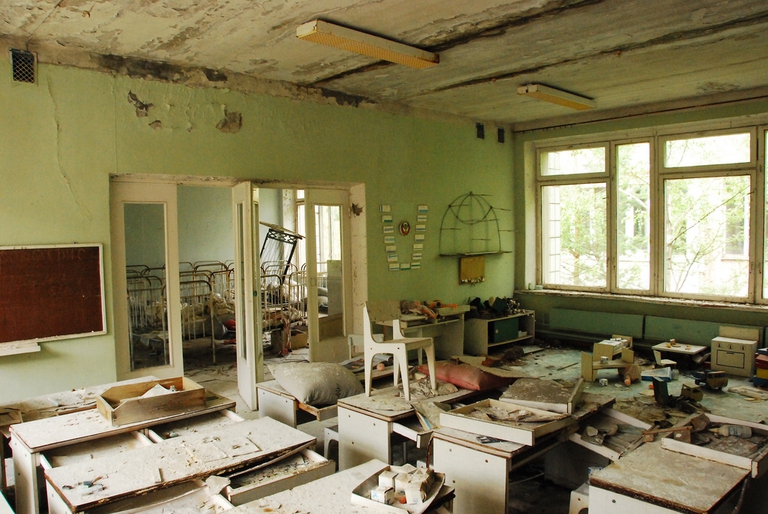
A group of experts in Tokyo suggested pouring radioactive water from Fukushima into the open sea. A marine biochemist explains the consequences of this absurd decision.
The first one megawatt solar power plant in the Chernobyl exclusion zone has become operational. This is the first step in a renewable energy development project promoted by the Ukrainian government in the area.
The first solar power plant in Chernobyl, Ukraine is now functioning. Renewable energy production is being developed as a mechanism to restore the dignity and purpose of a land devastated by the worst accident in the history of energy generation. The long-term health effects of the 1986 disaster are only just beginning to come to light. The solar plant has been built on land within the Chernobyl exclusion zone, an area that extends up to 30 kilometres in every direction around the former nuclear power station’s reactors, which will remain contaminated and abandoned for 24,000 years, according to experts’ calculations.
The solar power project is being promoted by the Ukrainian government, which enacted legislation to carry out energy sector projects in 2016. The ultimate objective is to transform the area surrounding Chernobyl into a power station capable of generating one gigawatt of electricity, enough to power 100 million LED lightbulbs. Since the introduction of the legislation, several international companies have expressed their interest in taking part in the programme. At the beginning of 2017, PV Magazine revealed that talks were ongoing between Ukraine’s government and French energy giant Engie, in addition to a feasibility study supported by the French government.
The Ukrainian government’s project has attracted investors’ and insurance companies’ interest. “It is cheap land, and abundant sunlight constitutes a solid foundation for the project,” Ostap Semerak, Ukrainian Minister for the Environment and Natural Resources, claimed in an interview with British daily The Guardian.
Many large companies have expressed their interest in investing in the area, from Chinese (GCL System Integration Technology Co Ltd. and China National Complete Engineering Corp), French (Engie) to German ones (Enerparc), but dozens of small investors have also started installing solar farms. The amount of interest is impressive, especially considering the difficulties that come with undertaking a project in a nuclear contamination zone, where important security implications come into play.
Chernobyl’s now operational 1.2 million dollar solar energy project was developed by Rodina Energy Group – the Ukrainian engineering society behind several renewable energy projects in eastern European and post-Soviet countries – together with German partner Enerparc AG, specialised in photovoltaic and solar technologies. The photovoltaic plant is made up of 3,762 modules installed on the site using specially-developed foundation and mounting systems to guarantee safety, considering the characteristics of the land around Chernobyl. The plant has a total output of one megawatt and produces enough electricity to power 2,000 homes.
Even if it’s only a small part of the one gigawatt project, the launch of Rodina Energy Group and Enerparc AG’s solar power station represents the first concrete step in restoring the area’s use after lengthy discussions among solar power experts and politicians. Even though the exact specifications of all the plants needed to reach one gigawatt haven’t been clearly defined yet – if such a result can be achieved in the first place – the Ukrainian government continues to work in this direction, and is currently evaluating projects that would result in a 100 megawatt output being accomplished in the medium term.
Siamo anche su WhatsApp. Segui il canale ufficiale LifeGate per restare aggiornata, aggiornato sulle ultime notizie e sulle nostre attività.
![]()
Quest'opera è distribuita con Licenza Creative Commons Attribuzione - Non commerciale - Non opere derivate 4.0 Internazionale.
A group of experts in Tokyo suggested pouring radioactive water from Fukushima into the open sea. A marine biochemist explains the consequences of this absurd decision.
A federal court in Washington, D.C. has struck down the Dakota Access Pipeline, following years of campaigning by the Standing Rock Sioux tribe.
The Scottish island of Eigg is self-sufficient for its energy needs, relying almost entirely on renewable sources, especially thanks to a coordinated community effort.
President Magufuli in unmovable in going ahead with the Stiegler’s Gorge dam despite conservationists’ warnings of the damage it will cause the Selous Game Reserve’s ecosystem and wildlife.
A large dam along the Luangwa River in Zambia would have posed a serious risk to local people and wildlife, leading hundreds of thousands to oppose it. A call to which the government responded by halting plans to build it.
A tanker exploded at a gas and petrol station in Nigeria’s Nasarawa state on the 10th of September, killing 35 people and leaving some burned beyond recognition; 3 citizens had several spine and brain injuries, 2 of them are still on Intesive Care Units. Fela Habila , a local singer, is now stable and out of danger but
The largest tidal power plant in the world will be built in the Larantuka Straits. It will serve 100,000 people and help overcome some of the challenges of energy provision in Indonesia.
Robben Island’s solar energy micro-grid project will produce almost one million kilowatt hours of electricity annually, significantly reducing the cost and impact of buying diesel.
The Balikpapan oil spill off the coast or Borneo in Indonesia covers 120 square kilometres. It has caused the death of 5 people, health and economic problems for local communities, as well as threatening wildlife and local ecosystems.










